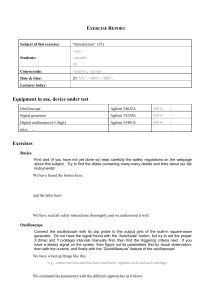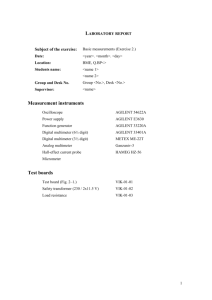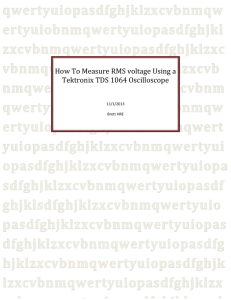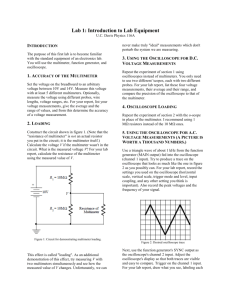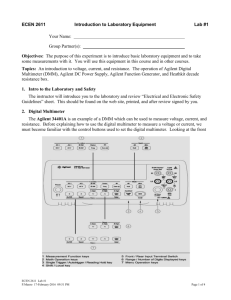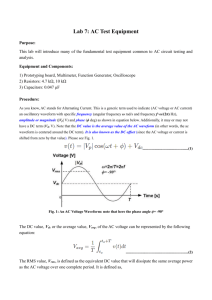Instrumentation Tutorial - Electrical and Computer Engineering at
advertisement
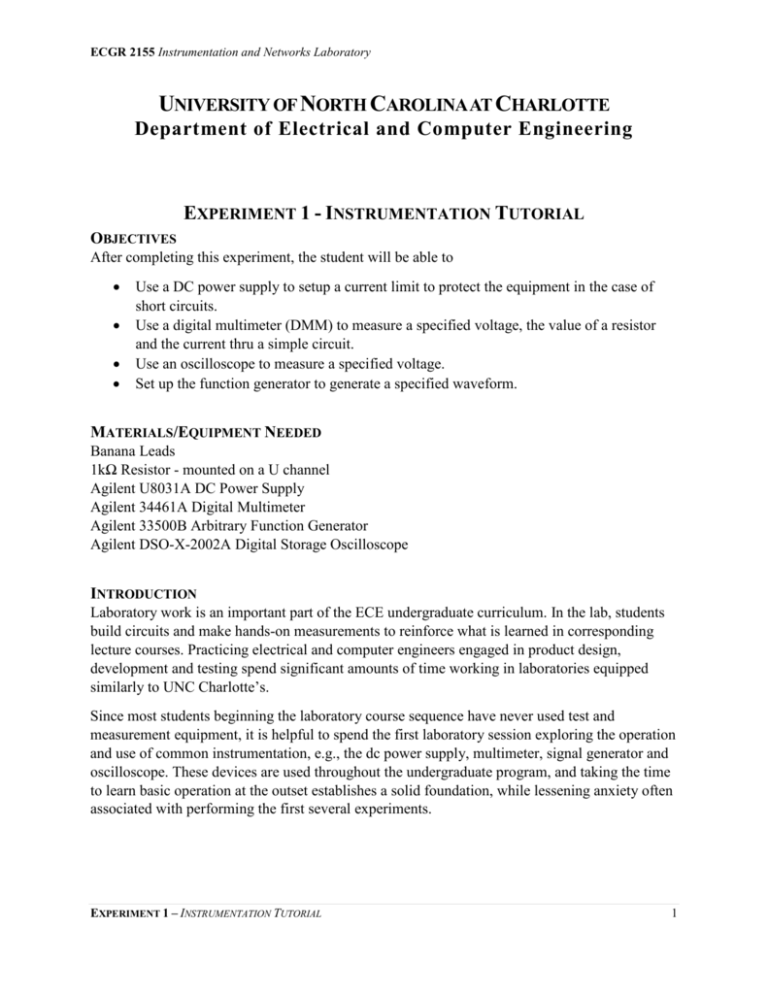
ECGR 2155 Instrumentation and Networks Laboratory UNIVERSITY OF NORTH CAROLINA AT CHARLOTTE Department of Electrical and Computer Engineering EXPERIMENT 1 - INSTRUMENTATION TUTORIAL OBJECTIVES After completing this experiment, the student will be able to • • • • Use a DC power supply to setup a current limit to protect the equipment in the case of short circuits. Use a digital multimeter (DMM) to measure a specified voltage, the value of a resistor and the current thru a simple circuit. Use an oscilloscope to measure a specified voltage. Set up the function generator to generate a specified waveform. MATERIALS/EQUIPMENT NEEDED Banana Leads 1kΩ Resistor - mounted on a U channel Agilent U8031A DC Power Supply Agilent 34461A Digital Multimeter Agilent 33500B Arbitrary Function Generator Agilent DSO-X-2002A Digital Storage Oscilloscope INTRODUCTION Laboratory work is an important part of the ECE undergraduate curriculum. In the lab, students build circuits and make hands-on measurements to reinforce what is learned in corresponding lecture courses. Practicing electrical and computer engineers engaged in product design, development and testing spend significant amounts of time working in laboratories equipped similarly to UNC Charlotte’s. Since most students beginning the laboratory course sequence have never used test and measurement equipment, it is helpful to spend the first laboratory session exploring the operation and use of common instrumentation, e.g., the dc power supply, multimeter, signal generator and oscilloscope. These devices are used throughout the undergraduate program, and taking the time to learn basic operation at the outset establishes a solid foundation, while lessening anxiety often associated with performing the first several experiments. EXPERIMENT 1 – INSTRUMENTATION TUTORIAL 1 ECGR 2155 Instrumentation and Networks Laboratory PRELAB “Pre-Labs” are prepared and turned in at the beginning of each week’s laboratory session. Prelabs are homework assignments that help students to prepare for laboratory experiments. Below is the Pre-Lab exercise for this experiment. 1. Find and review (do not attempt to read completely) the user manuals for the following instruments: a. Agilent U8031A DC Power Supply b. Agilent 34461A Digital Multimeter c. Agilent 33500B Arbitrary Function Generator d. Agilent DSO-X-2002A Digital Storage Oscilloscope 2. Answer the following questions: a. For the power supply, what are the ranges for voltage and current output? b. For the power supply, what is the procedure for constant current operation setup? c. For the multimeter, what three basic electrical quantities can be measured? d. What is the maximum dc voltage that can be measured using the multimeter? e. What different kinds of waveforms can be generated by the function generator? f. What is the frequency range of the function generator? g. How many signals can be measured simultaneously using the oscilloscopes in the lab? h. What is the bandwidth of the oscilloscopes in the lab? EXPERIMENT 1 – INSTRUMENTATION TUTORIAL 2 ECGR 2155 Instrumentation and Networks Laboratory PROCEDURE Note: The laboratory instructor will guide students through this first experiment step-by-step, with students following along. For all other experiments, students will work on their own in groups, with assistance from the instructor as needed. DC Power Supply 1. Examine the front panel of the power supply, turn the power supply on by pressing the power button on the lower left front panel. 2. Set the voltage of “output 1” to 10 V. 3. Set the current range button to 0.3A by a. Pressing the Display Limit button and then moving to the current limit by pressing the Voltage/Current button. b. Adjust the current limit to 0.30 by turning the adjust knob. c. Press the Display Limit button to set the current limit. The current control limit is now set to 0.3A, meaning that the power supply cannot source more than 300 mA, regardless of what is connected to the output terminals. This protects equipment from damaging high current due to a “short circuit” (zero ohms) across the output terminals. 4. Connect a banana lead (Figure 1-1) between the + and – output terminals of output 1. a. The voltage display becomes zero, and the current display indicates 300 mA, the current limit. No voltage can appear across a “short circuit”. 5. Disconnect the banana lead. Figure 1-1 Banana lead Digital Multimeter 1. Examine the front panel of the Digital Multimeter, the multimeter measures three basic electrical quantities; Voltage (V), Current (I), and Resistance (Ω). a. The quantity to be measured is selected by pressing the buttons (DCV, DCI, ACV, ACI or Ω). EXPERIMENT 1 – INSTRUMENTATION TUTORIAL 3 ECGR 2155 Instrumentation and Networks Laboratory b. There are six input connections at the right side of the front panel. The column of inputs on the far right are most commonly used. Notice that the top connector is labeled “VΩ” and the bottom one is labeled “I”. The “VΩ” terminal is used for measuring voltage or resistance. The “I” terminal is used for current measurements. c. Voltage and resistance are always measured “across” a device (between two points). Current flows “through” a complete circuit, and must be measured by making the current flow through the meter. In engineering terminology, a voltmeter is connected in “parallel”, while an ammeter is connected in “series”. d. The two connections below the label “Sense Ω4W” are for precision four-wire resistance measurements. This resistance measurement technique is used in an experiment later in the course. 2. Press the “Power” button at the lower left of the front panel to turn on the multimeter. a. Pres “DCV” to select DC voltage measurement mode. b. Using two banana leads, connect the voltmeter in parallel with the power supply output by connecting one banana lead between the “LO”, or common terminal of the meter and the “-“ output terminal of the power supply, and then connecting the other between the “V Ω” terminal of the meter and the “+” output terminal of the power supply. c. Set the voltage of output 1 of the power supply to 10 V. The displays of the power supply and multimeter should indicate essentially the same voltage, but the multimeter reading is more precise. d. Disconnect the banana leads from the power supply + and -. 3. Locate a 1kΩ resistor mounted on a U channel (Figure 1-2). Use the banana leads to connect the multimeter to the resistor. a. Observe the multimeter display, which reads near zero. The resistance measurement mode must be selected to be “Ω4W”. b. The meter will indicate the value of the resistor in ohms or kilohms. Record the measured resistance value, and the value printed on the resistor (nominal) on the DATA SHEET. c. Disconnect all banana leads. Figure 1-2 Resistor 4. To measure current, a simple series circuit must be constructed, with the multimeter as part of the current path. Starting at the “+” output terminal of the power supply: a. Connect one end of a banana lead to the “+” terminal of the power supply. b. Connect the other end to one of the resistor terminals. c. Connect one end of a banana lead to the remaining resistor terminal. d. Connect the other end of the banana lead to the “I” input terminal of the multimeter. EXPERIMENT 1 – INSTRUMENTATION TUTORIAL 4 ECGR 2155 Instrumentation and Networks Laboratory e. Connect one end of a banana lead to the “LO” input terminal of the multimeter. Connect the other end to the “-“ output terminal of the power supply. f. Press “Shift” then “DCI” to select DC current measurement mode. g. Trace the flow of the current from the positive power supply terminal, through the resistor and multimeter, and back to the negative power supply terminal. h. Record the measured values of current displayed on the multimeter, and voltage displayed on the power supply, in the DATA SHEET. i. Adjust the voltage output of the power supply and observe the change in current. Does current increase or decrease as voltage increases? j. Disconnect the series circuit and turn off the multimeter. Oscilloscope 1. Examine the front panel of the Digital Storage Oscilloscope. The oscilloscope is most often used to display a graph of voltage vs. time, commonly known as a “waveform”. a. The left side of the instrument is the display. b. Soft keys below the display select various functions indicated on the display. c. Controls are logically grouped on the right side of the oscilloscope. 2. Turn on the oscilloscope by pressing the power button located on the bottom left of the instrument. It will take a few minutes for the oscilloscope to self-test and initialize. 3. Meanwhile, the oscilloscope probe (Figure 1-3) can be explained. a. The oscilloscope probe consists of a probe tip and BNC (Bayonet Neill-Concelman) connector on either end of a coaxial cable. b. The probe tip – used for connecting to the circuit where voltage is to be measured -- has a removable, spring-loaded “grabber” that can be removed (Figure 1-4) for probing in restricted areas. c. The alligator clip is connected to the “common” or “ground” reference point. (Remember that voltage is always measured between two points.) Figure 1-3 Oscilloscope probe EXPERIMENT 1 – INSTRUMENTATION TUTORIAL 5 ECGR 2155 Instrumentation and Networks Laboratory Figure 1-4 Probe tip with grabber removed 4. Use the BNC connector at the other end of the coaxial cable to attach the probe to the oscilloscope’s CH1 or CH2 input. Align the oscilloscope connector’s lugs with the slots in the probe connector, push, and twist clockwise to lock. 5. A note of caution when handling the oscilloscope probe: The coaxial cable is relatively fragile due to its construction, consisting of a fine center conductor surrounded by a dielectric layer that is covered by a braided shield. The coaxial cable is designed to provide uniform impedance along its length for efficient signal transfer. Kinking the cable, rolling over it with a chair, etc. may permanently damage it. Always loosely coil the probe cable as shown in Figure 1-3 before returning it to the lab kit. 6. DC Voltage Measurement a. Press the “Auto Scale” key at the top right of the oscilloscope’s front panel to remove any settings made by previous users of the instrument. b. To measure DC voltage using the oscilloscope, with the DC power supply on and set to 10V, connect banana leads to the power supply’s “+” and “-“ output connectors. c. Connect the oscilloscope probe tip to the positive banana lead, and the ground clip to the negative lead (see Figure 1-5). d. In the vertical amplifier section press the CH1 menu key (yellow), the channel one menu labels will appear at the bottom of the display on top of the soft keys. (If the green channel two trace is visible, it can be toggled off by pressing the CH2 menu button.) Figure 1-5 Probe connections for DC voltage measurement EXPERIMENT 1 – INSTRUMENTATION TUTORIAL 6 ECGR 2155 Instrumentation and Networks Laboratory e. Press the “coupling” soft key several times to toggle through the coupling modes. In “AC” coupling mode, the DC component of a signal is filtered out and not displayed. This mode is useful for measuring small AC components of primarily DC signals, e.g., ripple on the output of a DC power supply. “DC” (direct coupling) displays the complete signal being measured. f. The “Probe” soft key is used to match the oscilloscope input to the multiplication factor selected by the sliding switch on the probe tip. 1X gives a one-to-one display of the signal being measured. 10X displays the measured signal at 1/10 of its actual value. This is used for measuring signals that exceed the oscilloscopes maximum input voltage specification. For this session, set the oscilloscope and probe to 1X. g. Select “DC” coupling and observe the oscilloscope display. Adjust the “position” control knob of the channel one horizontal amplifier until the yellow “1” arrow at the left of the display is aligned with the major horizontal axis. This indicates the zero (or ground) reference voltage. h. Turn the “VOLTS/DIV” knob until 5V per division is indicated for CH1 on the display. A horizontal line is displayed two divisions above the reference axis. The oscilloscope displays voltage on the vertical axis and sweeps time from left to right along the horizontal axis. Since the voltage being measured is DC, it does not vary with time and appears as a flat line. Its magnitude is 2 divisions times 5V per division, or 10 volts. i. Change the coupling mode from DC to AC. The trace moves to zero volts, because the measured signal is entirely DC, and this mode removes the DC component. Return to DC coupling. j. Press the “Invert” key to display the measured voltage as -10V (2 divisions below the reference.) Note that the measured voltage has not changed, only the way in which it is displayed. k. Toggle “Invert” to “Off”. l. Turn off the DC power supply and disconnect the banana leads and oscilloscope probe. Arbitrary Function Generator 1. Examine the front panel of the Arbitrary Function Generator. a. Press the power button in the lower left corner to turn on the instrument. b. Buttons to the right of the display select between waveform, parameters and units menus. Directly to the right are a keypad and knob used to enter numerical values for voltage amplitude and frequency. c. BNC output connectors are located at the lower right. 2. Find a coaxial cable having a BNC connector on one end and two alligator clips on the other (Figure 1-6) EXPERIMENT 1 – INSTRUMENTATION TUTORIAL 7 ECGR 2155 Instrumentation and Networks Laboratory Figure 1-6 BNC-to-Alligator cable 3. Attach the BNC end to the function generator output, and connect the other end to the channel one oscilloscope probe as shown in Figure 1-7. Be certain to attach the probe tip to the red alligator clip. 4. To set the function generator to output1 to a 10V, 10 kHz sine wave output: a. To select a sine function i. Press “Waveforms” ii. Select Sine b. To set the frequency i. Press “Parameters” ii. Select Frequency iii. Key in “10” iv. Select kHz c. To set the amplitude i. Press “Parameters” ii. Select Amplitude iii. Key in “10” d. To turn the channel output ON i. Press the channel 1 button ii. Set Output to ON Figure 1-7 Oscilloscope probe connection to BNC-to-Alligator cable EXPERIMENT 1 – INSTRUMENTATION TUTORIAL 8 ECGR 2155 Instrumentation and Networks Laboratory 5. In the Oscilloscope, a. Adjust the horizontal amplifier’s seconds per division knob to obtain a sweep rate of 50µs/div. b. Change the sweep rate by turning the seconds per division knob, and observe the effect. c. Return the sweep rate to 50 µs/div d. Turn the channel one volts per division knob, and observe the effect. Return to 5.00 V/div EXPERIMENT 1 – INSTRUMENTATION TUTORIAL 9 ECGR 2155 Instrumentation and Networks Laboratory DATA/OBSERVATIONS Nominal Resistance Measured Resistance Measured Voltage across the Resistor Measured Current through the Resistor INSTRUCTOR'S INITIALS: DATE: POST-LAB Post-Lab questions must be answered in each experiment’s laboratory report. 1. Apply Ohm’s law, V=IR, to explain why no voltage can appear across a short circuit. 2. How does Ohm’s law explain observed current change with increasing voltage across the resistor? 3. Use the voltage and current values recorded for the resistor to calculate the resistor’s value. Compare this calculated value to the resistance measured with the multimeter, and the value printed on the resistor. EXPERIMENT 1 – INSTRUMENTATION TUTORIAL 10

